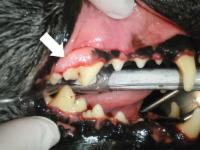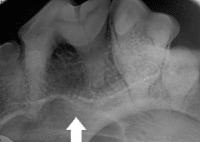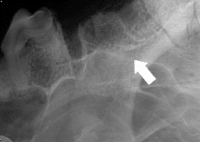Imagine if you could pick a superhero power. You'd probably pick flying or the ability to be invisible or super-strength. But veterinarians, especially those in dentistry, would probably choose x-ray vision. For now, they'll have to settle for dental x-rays.
It may seem like dental x-rays are arbitrary and just an added expense to you. After all, a lot of veterinary practices don't even have this available. The equipment is costly for the practice, it takes a special skill set to perform these X-rays-more cost to train staff, and even the veterinary community itself is just waking up to how important this is. AHNA includes dental x-rays as a part of every cleaning, and thinks they're imperative for two main reasons:
 Right Maxilla: After Ultrasonic Scaling
Right Maxilla: After Ultrasonic Scaling
1. This is probably the most important reason-there are things that cannot be seen without x-rays. A tooth may appear to look normal and healthy, even after cleaning. But the back of the tooth, which is difficult if not impossible to visualize thoroughly depending on the tooth, may be diseased. Or there may be an abscess (infection) of the root, or the root itself may be cracked. Regardless, these are all sources of pain and discomfort that would otherwise go unnoticed. If you've ever had a toothache, you know how painful they can be. Imagine not being able to communicate that pain. Dental X-rays give your pet a voice. We wouldn't want to guess if an animal has a broken bone, and the same is true with the teeth. Dental X-rays are an essential part of a cleaning, and give us information that we wouldn't otherwise have.
 Right Maxilla: Infected Tooth: Will Need To Be Extracted
Right Maxilla: Infected Tooth: Will Need To Be Extracted
2. After a tooth is extracted, an X-ray is important to ensure that no root fragments remain. Just a tiny sliver left behind can cause a painful abscess. (A retained root does not equal a poorly-skilled veterinarian-the root itself may be fractured, fragile, or dead.) When a tooth is extracted, the area is very vascular and causes bleeding. The veterinarian will probably not be able to see with the naked eye if there is a retained root; he/she will need an X-ray to visualize this.
 Right Maxilla: Post Extraction
Right Maxilla: Post Extraction
Keep in mind that a tooth sometimes has to be severely diseased before an animal will show any signs that something is amiss. We've seen animals that literally had teeth falling out that ate normally. But this doesn't mean that they aren't in pain: maybe they've adapted by just chewing on the other side or swallowing kibble whole or just accepting that eating is painful. But there may still be something going on that we can't see.

